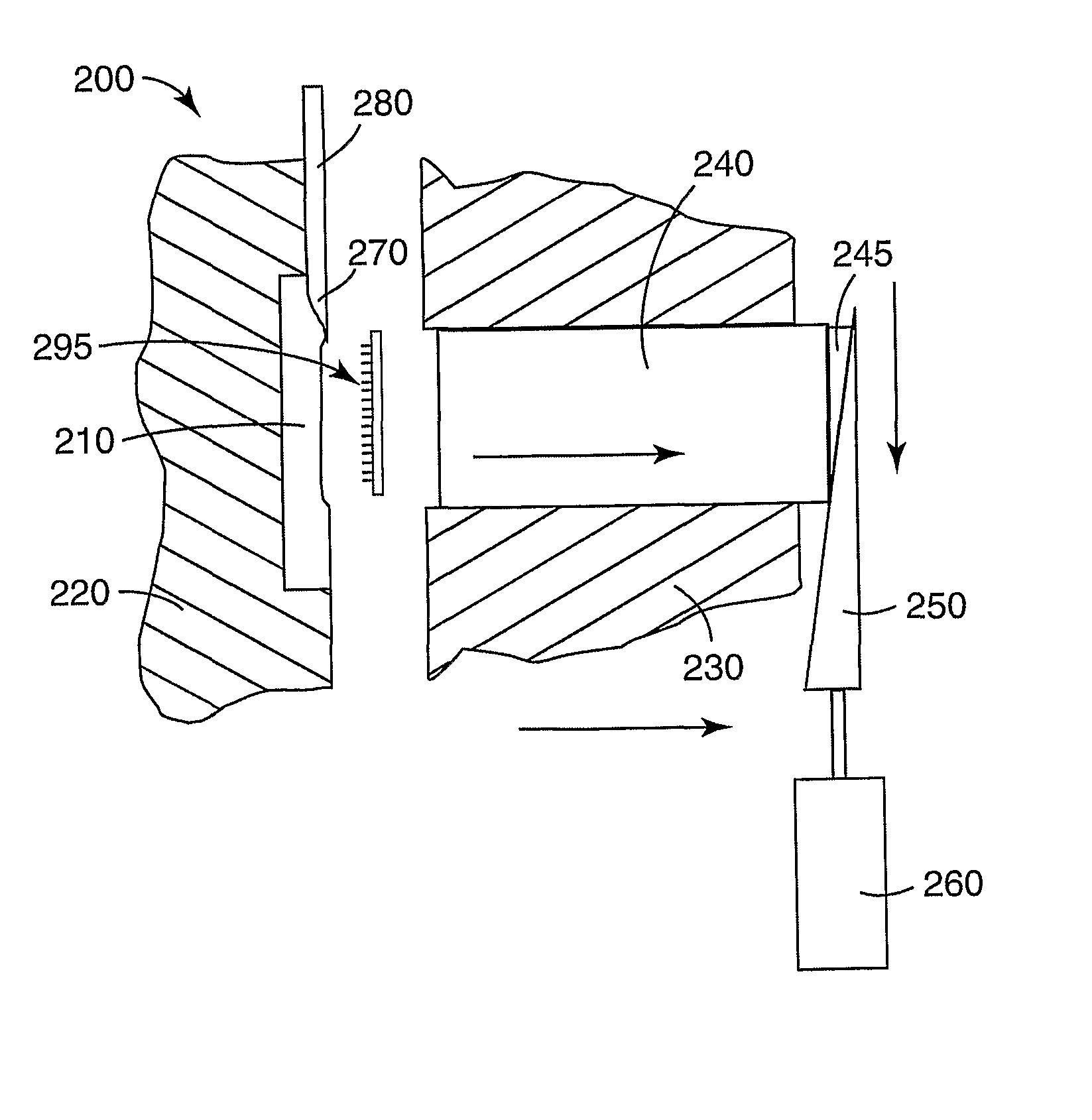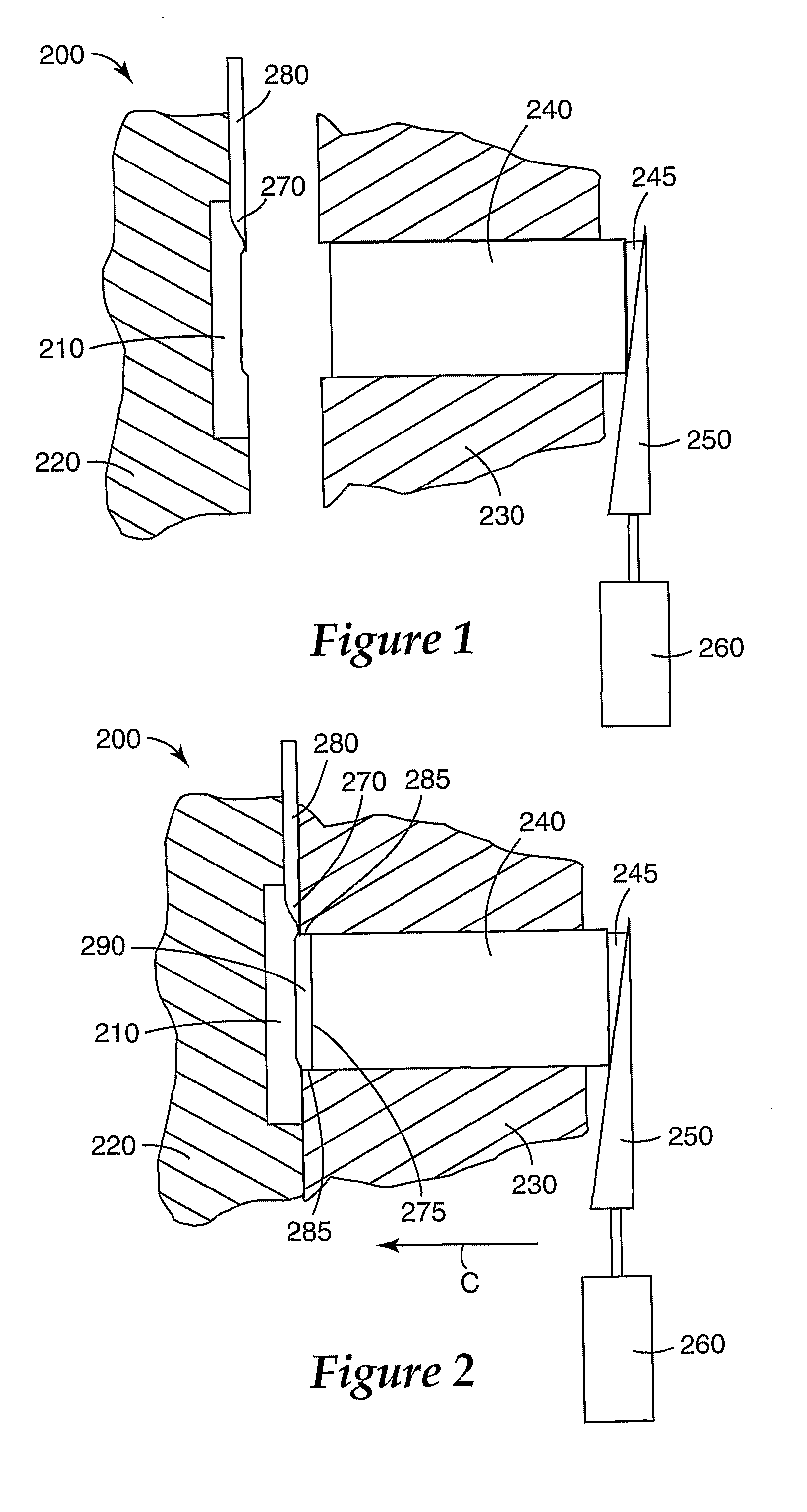Method Of Molding A Microneedle
a microneedle and array technology, applied in the field of microneedle array molding, can solve the problems of limited number of molecules demonstrated, and difficult preparation of microneedle arrays
- Summary
- Abstract
- Description
- Claims
- Application Information
AI Technical Summary
Benefits of technology
Problems solved by technology
Method used
Image
Examples
example 1
[0065] Molded microneedle arrays were prepared using a 55-ton injection molding press (Milacon Cincinnati ACT D-Series Injection Molding Press) equipped with a thermocycling unit (Regoplas 301 DG Thermal Cycling Unit) in an apparatus as generally shown in FIGS. 1 to 4. Polycarbonate pellets (Lexan® HPS1R-1125, GE Plastics, Pittsfield, Mass.) were loaded into a reciprocating screw and heated until molten. The negative mold insert was heated to a temperature (hereafter referred to as the “mold temperature at injection”) of 340° F. (171.1° C.). The mold insert was shaped to provide a microneedle array having a substrate in the shape of a circular disk with an area of 2 cm2. The mold insert was partially patterned with cavities in the form of the negative image of an array of microneedles (37×37) in a square shape (1 cm2) in the center of the circular disk. The microneedle cavities were regularly spaced with a distance of 275 microns between the tips of adjacent microneedle cavities in ...
example 2
[0066] Microneedle arrays were prepared as in Example 1 with the following exceptions. The second mold member had a fixed face and thus no compression step was used (i.e., as shown in FIG. 11A). The mold temperature at injection and the mold temperature at ejection were both 200° F. (93.3° C.), that is, the mold temperature remained constant. Ultrasonic energy was applied to the mold insert as generally shown in FIG. 10. The ultrasonic energy was turned on before application of the pack pressure (approximately 0.5 second after the onset of injection of molten material) and was applied for approximately 1.0 second. The frequency was 20,000 Hz and the amplitude of motion of the ultrasonic horn was 1.5 mil (38.1 μm). The average microneedle height thus formed was 240 μm as measured by viewing with a stereomicroscope.
example 3
[0067] Microneedle arrays were prepared as in Example 1 with the following exceptions. The mold temperature at injection and the mold temperature at ejection were both 200° F. (93.3° C.), that is, the mold temperature remained constant. Ultrasonic energy was applied to the mold insert as generally shown in FIG. 10. The ultrasonic energy was turned on before application of the pack pressure (approximately 0.5 second after the onset of injection of molten material) and was applied for approximately 1.0 second. The frequency was 20,000 Hz and the amplitude of motion of the ultrasonic horn was 1.5 mil (38.1 μm). The average microneedle height thus formed was 245 μm as measured by viewing with a stereomicroscope.
PUM
| Property | Measurement | Unit |
|---|---|---|
| temperature | aaaaa | aaaaa |
| distance | aaaaa | aaaaa |
| surface area | aaaaa | aaaaa |
Abstract
Description
Claims
Application Information
 Login to View More
Login to View More - R&D
- Intellectual Property
- Life Sciences
- Materials
- Tech Scout
- Unparalleled Data Quality
- Higher Quality Content
- 60% Fewer Hallucinations
Browse by: Latest US Patents, China's latest patents, Technical Efficacy Thesaurus, Application Domain, Technology Topic, Popular Technical Reports.
© 2025 PatSnap. All rights reserved.Legal|Privacy policy|Modern Slavery Act Transparency Statement|Sitemap|About US| Contact US: help@patsnap.com



